Table of Contents
This guide explores the top platforms for 2025, providing the insights you need to choose the best fit for your skills and career goals, from bustling marketplaces to the ultimate platform: your own professional website.
Understanding the Freelance Platform Landscape in 2025
The way we work is continuously evolving, and freelancing has cemented its place as a significant part of the global workforce. To navigate this space effectively, it helps to understand the current trends and know what to look for in a platform.
The Growing Gig Economy: Key Statistics for 2025
The freelance movement is more than a trend; it’s a fundamental shift in the employment landscape. Consider these figures:
- The global gig economy is projected to reach nearly $900 billion by 2027, showcasing its massive growth trajectory.
- Studies indicate that over 50% of the US workforce may participate in freelance work in some capacity within the next few years.
- Freelancers with in-demand skills, particularly in tech and creative fields, often report earning more per hour than their traditionally employed counterparts. This highlights the financial viability of a freelance career when approached strategically.
These statistics confirm that opportunities are abundant. The key is knowing where to find them and how to position yourself for success.
How to Choose the Right Freelance Website for You
With so many options available, selecting a platform can feel overwhelming. Focus on these core factors to make an informed decision that aligns with your professional journey.
Consider Your Niche and Skill Level
Are you a web developer, a graphic designer, a writer, or a virtual assistant? Some platforms cater to a broad range of skills, while others are highly specialized. Similarly, some sites are beginner-friendly, while others, like Toptal, are designed exclusively for elite, senior-level talent. Matching the platform’s focus with your expertise is crucial.
Evaluate Platform Fees and Payment Structures
Freelance websites are businesses, and they make money by taking a percentage of your earnings. These fees can vary significantly. Some use a flat commission, while others have a sliding scale that decreases as you earn more with a single client. Understand the fee structure, including any charges for membership, bidding on projects, or withdrawing funds.
Assess the Quality and Quantity of Job Postings
Spend some time Browse the job listings on any platform you’re considering. Are the projects a good fit for your skills? Do the clients seem professional and legitimate? A platform with a high volume of low-quality, low-paying gigs might not be the best place to build a sustainable career. Look for a healthy balance of opportunities that match your income goals.
Look at Community and Support Features
A strong platform offers more than just job listings. Look for resources like educational content, community forums, and responsive customer support. These features can be invaluable for resolving disputes, answering questions, and helping you grow as a freelancer.
The Top Generalist Freelance Platforms
These platforms are the giants of the freelance world, offering a vast array of projects across nearly every industry imaginable. They are often a great starting point for both new and experienced freelancers.
1. Upwork: The All-in-One Giant
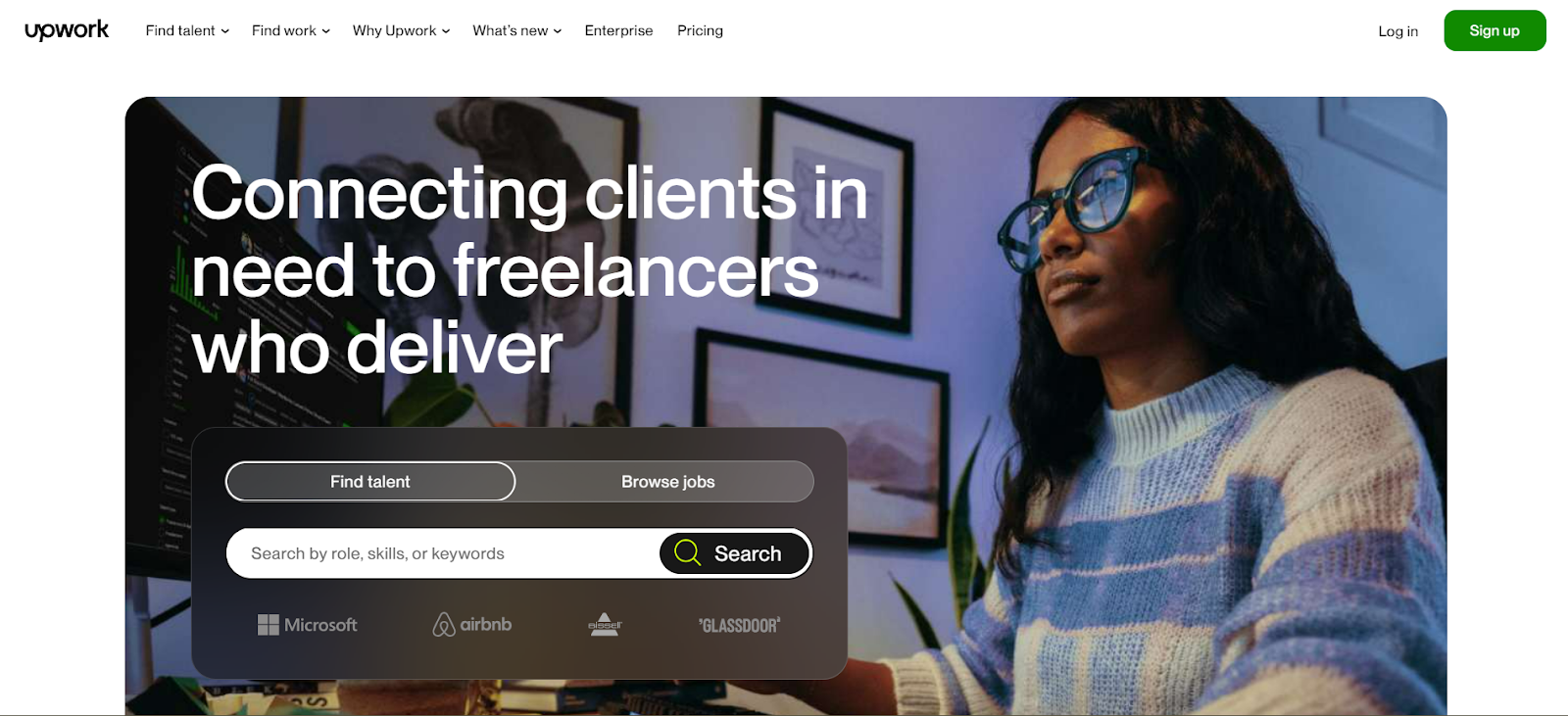
Upwork stands as one of the largest and most well-known freelance marketplaces globally. It connects millions of businesses with independent talent for projects ranging from simple, one-off tasks to complex, long-term collaborations.
What is Upwork?
Upwork is a comprehensive platform where clients post jobs and freelancers submit proposals to win them. It includes features for project management, time tracking, and secure payments, creating a complete ecosystem for remote work. The platform hosts a wide variety of job categories, including IT, design, marketing, writing, and administrative support.
Best For
Upwork is suitable for a broad spectrum of freelancers, from entry-level professionals looking to build a portfolio to established experts and even small agencies seeking high-value clients. Its sheer size means there is a constant flow of new opportunities.
Key Features
- Talent Marketplace: The traditional model where freelancers bid on jobs posted by clients.
- Project Catalog: Allows freelancers to create pre-packaged, fixed-price services, similar to Fiverr’s gig model.
- Robust Filtering: Advanced search capabilities help freelancers find projects that precisely match their skills, desired pay rate, and experience level.
- Payment Protection: An escrow system holds funds for fixed-price jobs, and the platform’s time-tracking tool for hourly jobs helps ensure you get paid for your work.
Pricing and Fees
Upwork uses a sliding scale service fee based on your lifetime billings with a specific client:
- 20% for the first $500 billed.
- 10% for lifetime billings between $500.01 and $10,000.
- 5% for lifetime billings that exceed $10,000.
This structure incentivizes building long-term relationships with clients.
Getting Started on Upwork
Success on Upwork begins with a strong profile. Treat it as your professional storefront. Use a high-quality photo, write a compelling summary of your skills and experience, and build a portfolio that showcases your best work. When applying for jobs, craft personalized proposals that directly address the client’s needs rather than sending generic, copied-and-pasted responses.
2. Fiverr: The Project-Based Marketplace
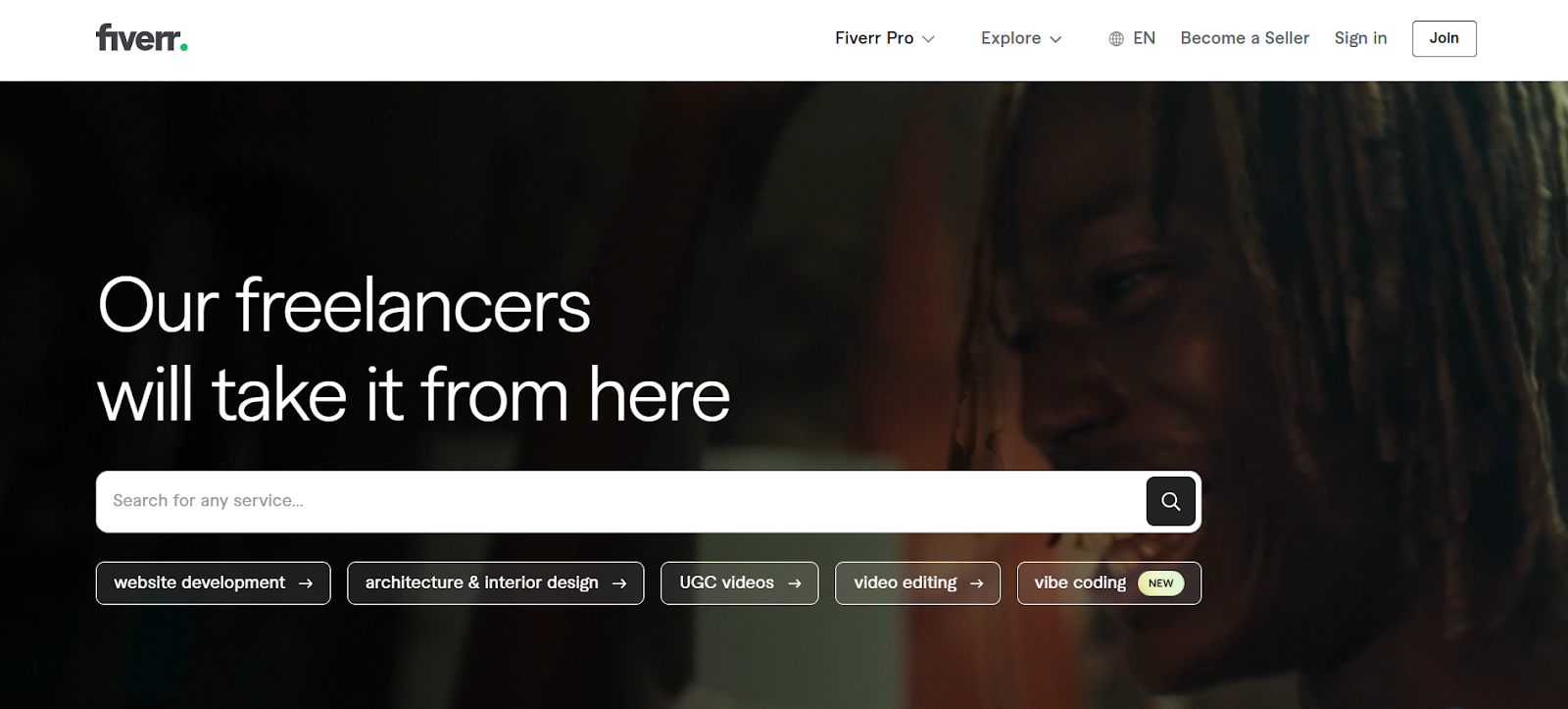
Fiverr revolutionized the freelance industry with its “gig” model, turning services into products. It’s an incredibly active marketplace, particularly for creative and digital services.
What is Fiverr?
On Fiverr, freelancers (called “sellers”) create listings for specific services, known as “gigs.” For example, instead of a client posting “I need a logo,” a designer creates a gig that says, “I will design a professional business logo for $100.” Clients then browse these gigs and purchase the one that best fits their needs.
Best For
Fiverr is ideal for freelancers who can offer a well-defined, repeatable service. It’s a powerhouse for graphic designers, voice-over artists, writers, video editors, and social media marketers. It’s also very accessible for beginners looking to get their first few clients and reviews.
Key Features
- Gig-Based Structure: Puts the freelancer in control of defining the service, price, and scope of work upfront.
- Tiered Packages: Sellers can offer Basic, Standard, and Premium packages for each gig, allowing them to upsell clients on more comprehensive services.
- Seller Levels: A leveling system (New Seller, Level One, Level Two, Top Rated Seller) rewards sellers with better visibility and perks based on performance, quality, and responsiveness.
- Fiverr Pro: An exclusive tier for hand-vetted, top-tier professionals, offering services to larger businesses at premium price points.
Pricing and Fees
Fiverr’s fee structure is straightforward. The platform takes a 20% commission on all earnings, including the main gig price, package extras, and any tips you receive.
How to Succeed on Fiverr
A successful Fiverr gig has a clear title, an engaging video or image gallery, and a detailed description. Research what top sellers in your niche are doing and find a way to differentiate your offering. Providing excellent customer service and encouraging positive reviews is essential for moving up the seller levels and gaining more visibility.
3. Freelancer.com: The Contest King
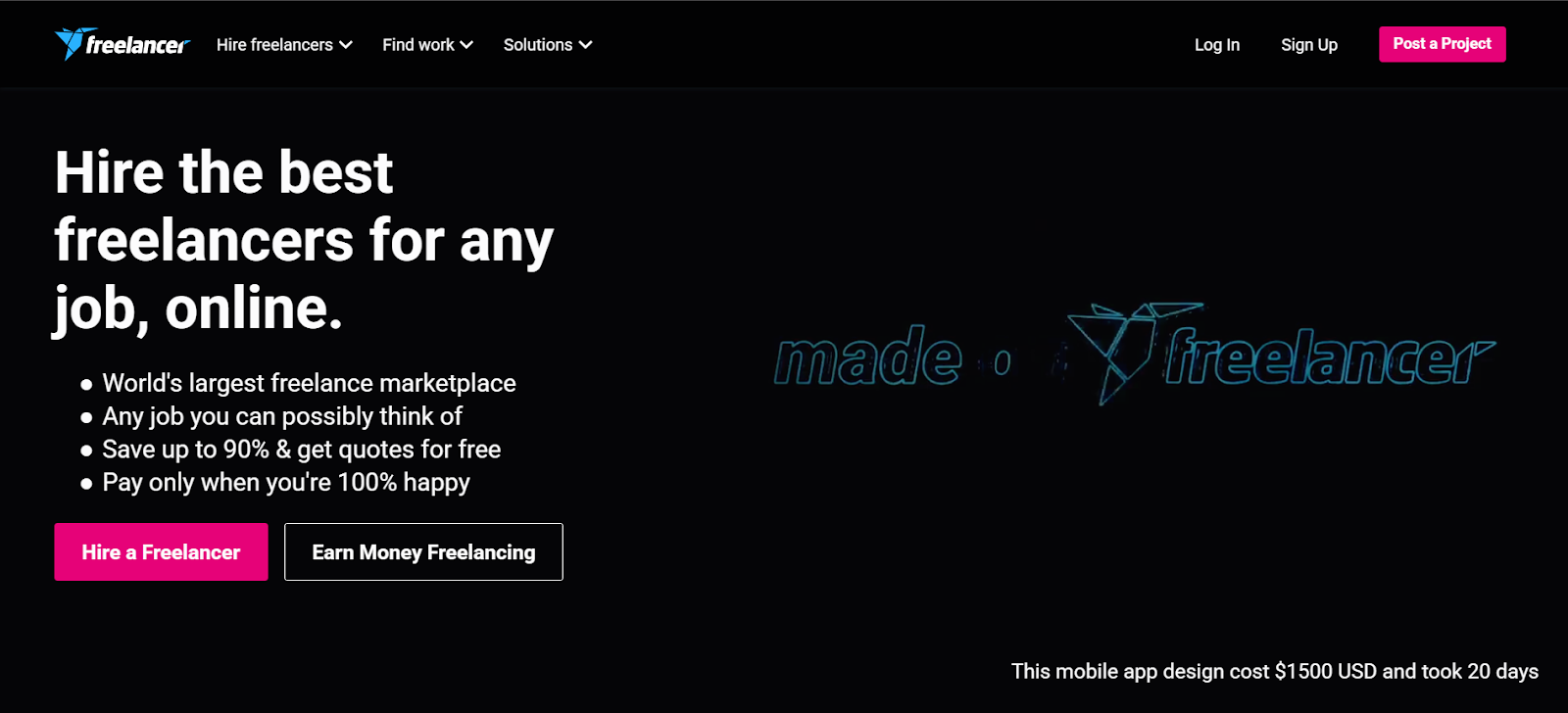
Freelancer.com is one of the oldest freelance marketplaces and boasts a massive user base of both clients and freelancers. It offers traditional projects but is particularly famous for its contest-based model.
What is Freelancer.com?
This platform is a bustling hub where businesses can find talent for a wide range of jobs. It operates on both a bidding system for hourly and fixed-price projects, much like Upwork, and a unique contest system.
Best For
Freelancer.com appeals to competitive individuals, especially in creative fields like graphic and logo design, who enjoy the challenge of a contest. It can be a way for new freelancers to build a portfolio quickly, even if they don’t win every contest, as they still have the design to showcase.
Key Features
- Hourly and Fixed-Price Projects: The standard model where freelancers bid on jobs.
- Contests: A client posts a brief (e.g., “Design a logo for my coffee shop”) and offers a prize amount. Freelancers submit their designs, and the client chooses a winner. This allows clients to see multiple options before paying.
- Milestone Payments: A secure payment system that releases funds as specific project milestones are completed and approved.
Pricing and Fees
The fee structure on Freelancer.com can be complex. There are various membership plans (from free to premium) that affect the number of bids you can place per month and the fees you pay. Project fees are typically around 10% for fixed-price projects, and contest winners also pay a fee on their prize money.
Best Niche-Specific Freelance Websites
While generalist platforms offer variety, niche websites provide a curated environment where you can connect with clients who are specifically looking for your unique skills. This can lead to higher-quality projects and less competition from freelancers outside your field.
4. Toptal: The Elite Network for Top Talent
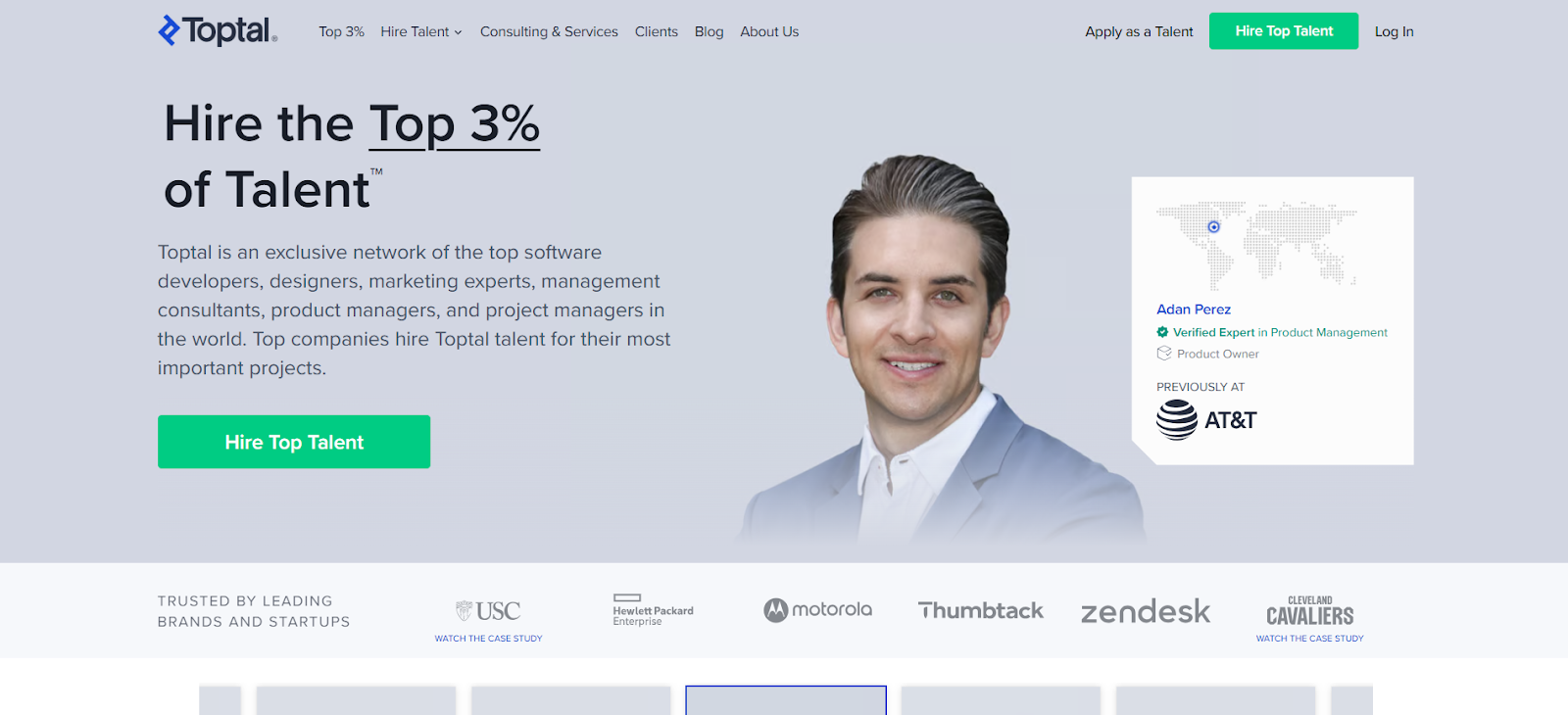
Toptal positions itself as a network for the “top 3% of freelance talent.” It’s not a platform for beginners but rather a destination for seasoned, highly skilled professionals.
What is Toptal?
Toptal is an exclusive platform that rigorously vets freelancers in fields like software development, finance, project management, and design. Businesses turn to Toptal when they need top-tier talent for critical, high-stakes projects.
Best For
This platform is exclusively for senior-level, experienced freelancers. If you are a top-performing software engineer, a data scientist with a proven track record, or a financial expert with years of experience, Toptal might be the right fit.
Key Features
- Rigorous Screening Process: A multi-stage process that includes language and personality tests, timed algorithm challenges, technical screenings, and live test projects. Only a fraction of applicants are accepted.
- High-Quality Clients: Toptal works with leading companies, from rapidly growing startups to Fortune 500 corporations.
- Premium Rates: Due to the high caliber of its talent, freelancers on Toptal can command significantly higher rates than on generalist platforms.
The Application Process
Be prepared for a challenge. The process typically involves a comprehensive English evaluation, a deep dive into your skills and knowledge, live screenings with experts, and a test project. Passing this gauntlet grants you access to a premier network of clients and projects.
5. 99designs by Vistaprint: The Creative Hub for Designers
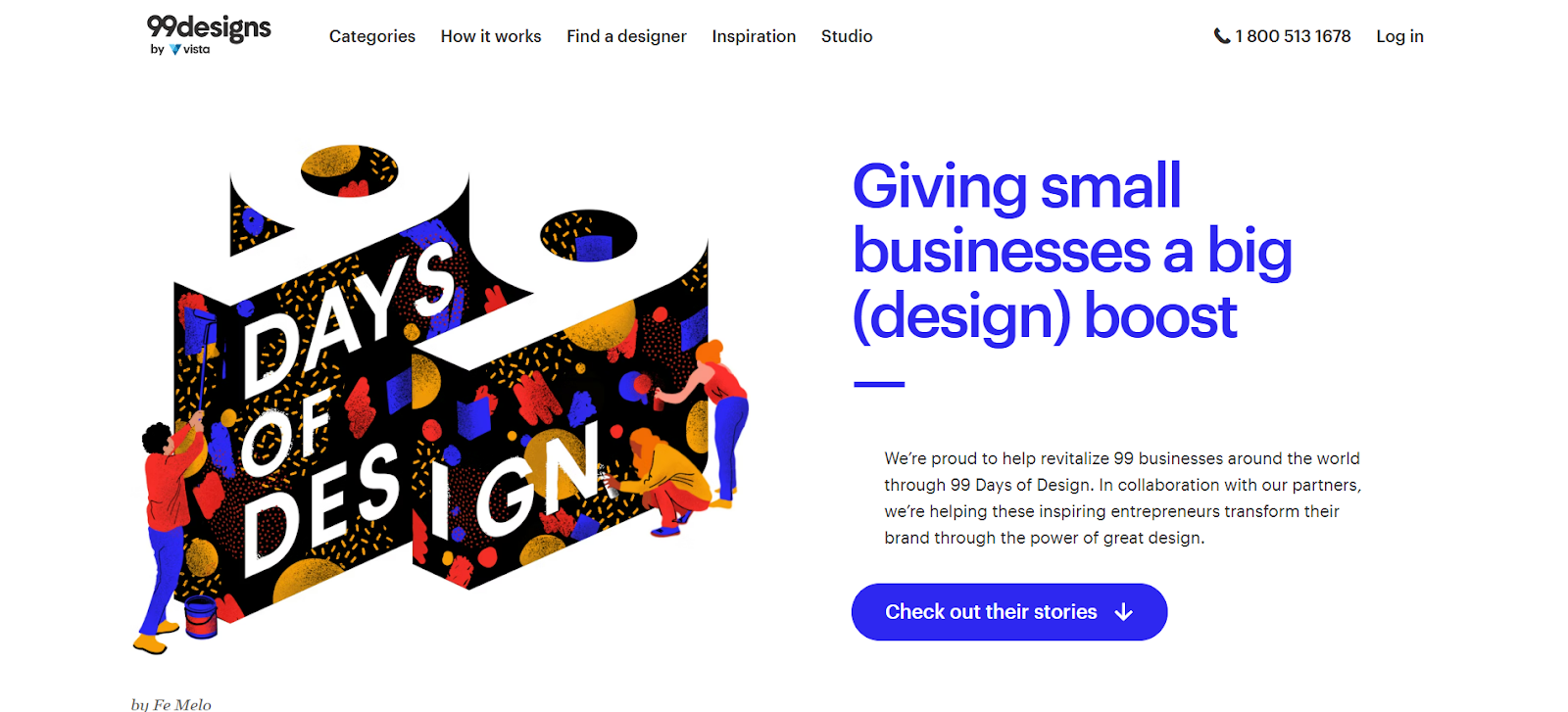
Acquired by Vistaprint, 99designs has solidified its position as the leading platform dedicated solely to graphic design.
What is 99designs?
It’s a global creative platform that allows clients to source design work. It’s famous for popularizing the design contest model but also facilitates direct work between designers and clients.
Best For
It is the go-to platform for graphic designers specializing in logos, branding, web design, book covers, and merchandise. It caters to all levels, from students building a portfolio to established freelance designers.
Key Features
- Design Contests: The core feature where a client launches a contest, designers submit concepts, and a winner is chosen and awarded the prize money.
- 1-to-1 Projects: Allows clients to browse designer portfolios and hire a specific designer directly for their project.
- Designer Leveling: Designers are categorized into Top, Mid, and Entry levels, helping clients find the right match for their budget and quality expectations.
How it Works
Freelancers can participate in contests to win projects and build their reputation. As you win contests and complete successful 1-to-1 projects, your designer level increases, making your profile more visible and allowing you to charge higher rates.
6. WriterAccess: A Content Creator’s Paradise
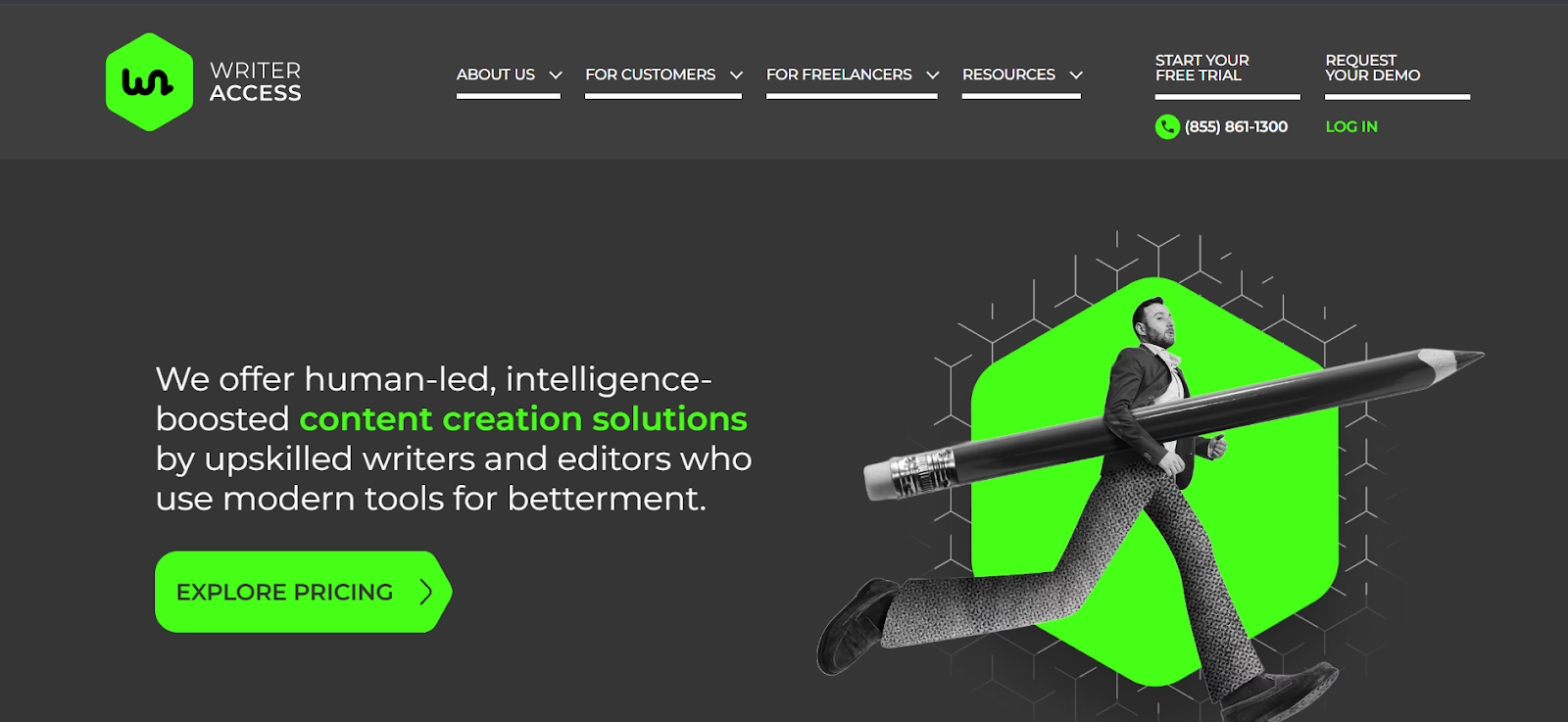
WriterAccess is a premium content marketing platform that connects businesses with professional writers, editors, content strategists, and translators.
What is WriterAccess?
This platform focuses exclusively on content creation. It uses a combination of AI-powered tools and human curation to match clients with the right talent for their specific content needs, from blog posts and white papers to ad copy and e-books.
Best For
It’s an excellent choice for experienced writers, editors, and content marketing professionals. They value quality and have a structured system for managing workflow and client expectations.
Key Features
- AI-Powered Search: Advanced tools help clients find freelancers based on industry, asset type, and tone of voice.
- Tiered Star Ratings: Freelancers are assigned a star rating (2 to 6 stars) based on an evaluation of their application and ongoing performance, which determines their pay rate.
- Managed Services: Offers a higher level of service where a dedicated team helps manage content strategy and production for larger clients.
7. Guru: The Experienced Professional’s Choice
Guru is another long-standing freelance platform that caters to experienced professionals across a variety of industries, with a strong focus on technical, creative, and business fields.
What is Guru?
Guru provides a flexible and secure platform for freelancers to find work and for employers to hire talent. It has been a reliable option in the freelance space for over two decades.
Best For
Experienced freelancers looking for long-term projects and who prefer a straightforward, professional platform. It’s less crowded than the mega-platforms, which can be an advantage for seasoned pros.
Key Features
- WorkRooms: A dedicated dashboard for each project that helps manage all communication, files, and payments in one place.
- Multiple Payment Terms: Offers flexibility with options for fixed-price, hourly, task-based, or recurring payments.
- Guru Score: Each freelancer has a reputation score based on feedback and transaction history, helping them build credibility.
Emerging and Specialized Platforms to Watch
The freelance ecosystem is always growing. These platforms are either newer to the scene or serve a unique niche, making them exciting options to consider for your freelance stack.
8. Contra: The Commission-Free Portfolio Platform
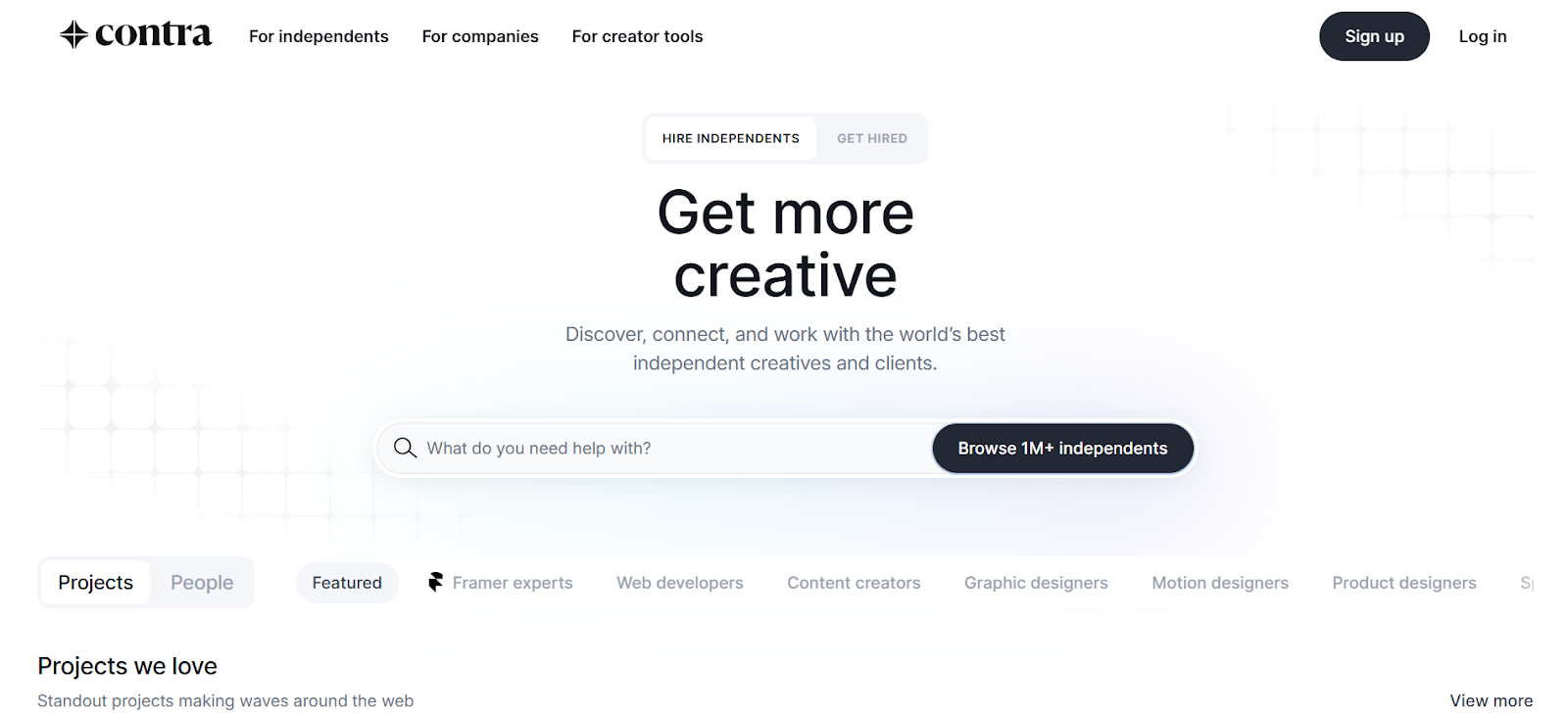
Contra is gaining significant traction, especially among the next generation of freelancers, with its forward-thinking, commission-free model.
What is Contra?
Contra is a professional network designed for independent work. It’s built around a portfolio-first approach, allowing you to showcase your work visually. Its most significant differentiator is its financial model.
Best For
This platform is fantastic for Gen Z and millennial freelancers, particularly in creative and tech fields like design, social media, and software development. It’s ideal for anyone who wants to avoid platform fees and build a strong, visual professional identity.
Key Features
- 0% Commission: Contra does not take any percentage of your earnings. You keep 100% of what you make.
- Built-in Portfolio Tools: The platform is designed to help you create a beautiful, dynamic portfolio to attract clients.
- Collaborative Features: Tools for creating project proposals, contracts, and managing payments are integrated directly into the platform.
9. Bark: The Local Service Connector
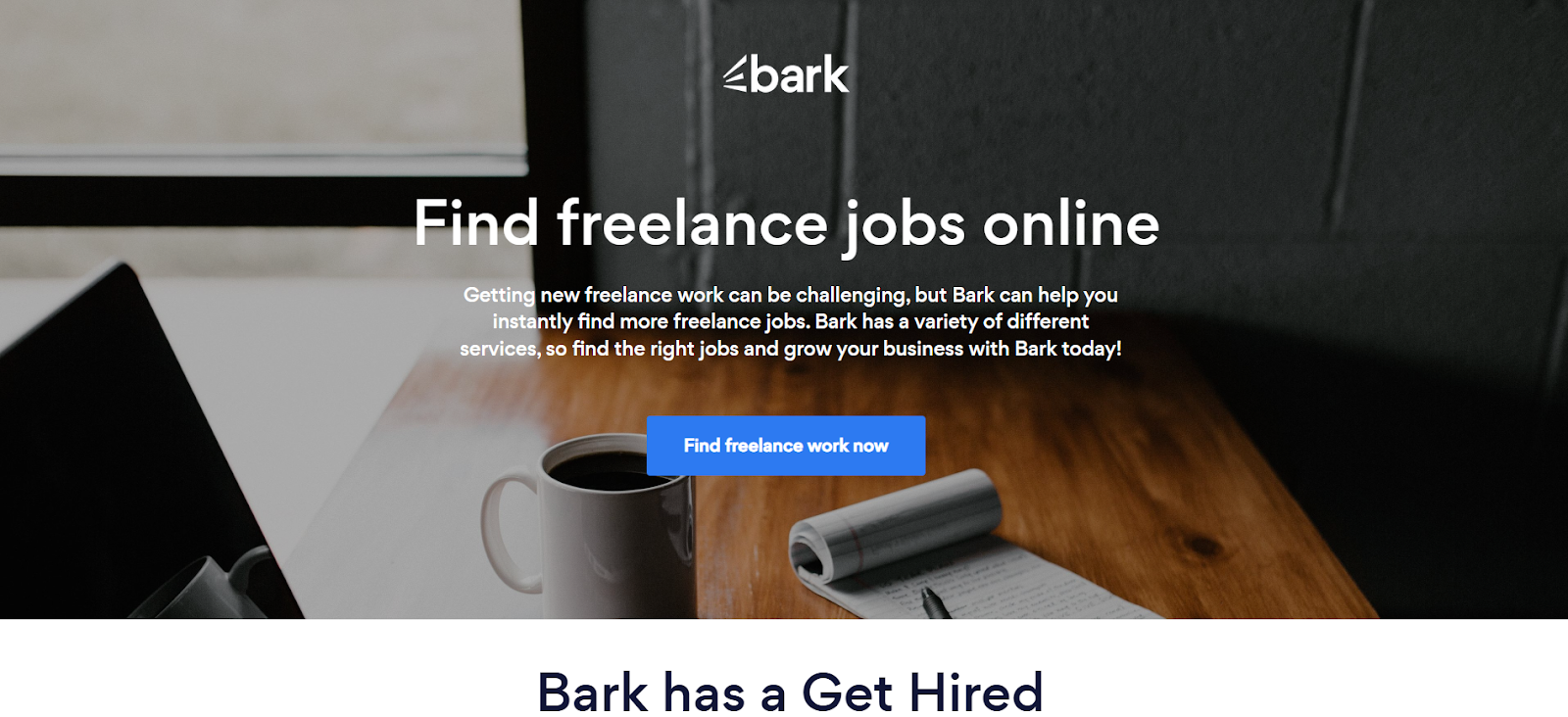
Bark takes a different approach by focusing on connecting customers with local service professionals, spanning both digital and in-person services.
What is Bark?
Bark is a lead generation service. Customers post a request for a service, and Bark matches them with relevant professionals. The freelancer then decides if they want to pay a fee to receive the customer’s contact information and provide a quote.
Best For
It’s a strong option for freelancers and small businesses that offer location-specific services. This includes photographers, personal trainers, music tutors, and even local digital marketers or IT support specialists.
10. PeoplePerHour: The UK-Based Powerhouse
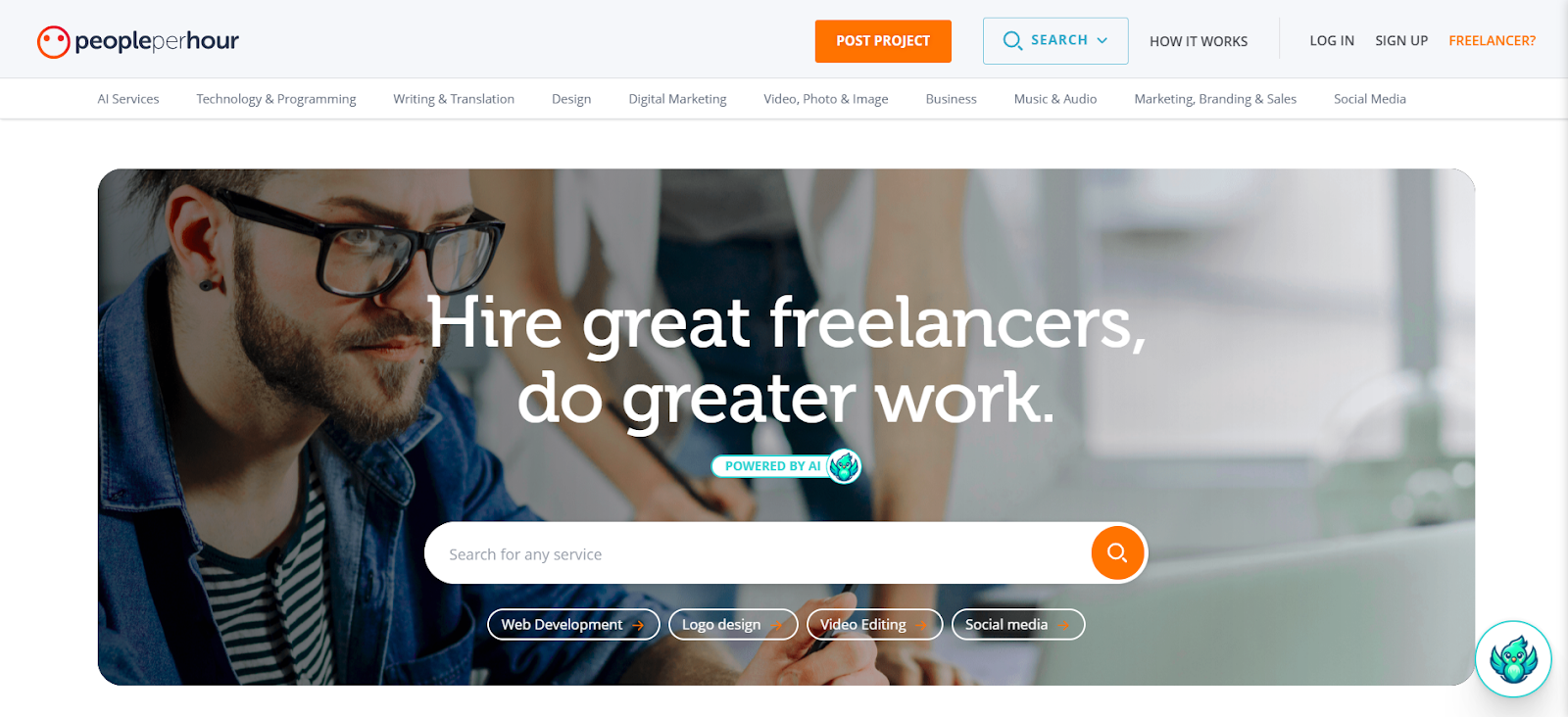
While global, PeoplePerHour has a significant presence in the United Kingdom and Europe. It combines elements from both Upwork and Fiverr.
What is PeoplePerHour?
This platform allows clients to post projects for freelancers to bid on. It also lets freelancers post “Hourlies,” which are fixed-price, pre-packaged services that clients can purchase directly.
Best For
It’s a great all-around platform for a mix of remote and local freelancers, especially those targeting the UK and European markets.
Key Features
- “Hourlies”: These are the platform’s version of Fiverr’s gigs, allowing freelancers to productize their services.
- AI-Powered Job Matching: An artificial intelligence system helps to sort through new projects and match them with the most suitable freelancers, saving time.
The Most Important Freelance Platform: Your Own Website
While freelance marketplaces are excellent for finding clients, the ultimate goal for any serious freelancer should be to build their own brand on their own platform. Your personal website is the only space online where you have complete control.
Why Every Freelancer Needs a Professional Website
Relying solely on freelance platforms means you are building your business on rented land. A professional website is an asset you own, and it offers unparalleled benefits.
Build Credibility and Authority
A well-designed website signals that you are a serious professional, not just a gig worker. It’s your digital headquarters, allowing you to tell your story, share your expertise through a blog, and build trust with potential clients before you even speak with them.
Showcase Your Best Work in a Portfolio
On a freelance platform, your portfolio is constrained by templates and upload limits. On your own site, you can create a stunning, custom portfolio that truly does justice to your work. You can include detailed case studies, testimonials, and high-resolution imagery without any restrictions.
Set Your Own Terms and Rates (No Commissions)
When a client hires you through your website, there are no platform commissions. Every dollar they pay goes directly to you. You also have complete control over your contracts, payment terms, and project scope.
Attract Clients Directly Through SEO
A website optimized for search engines can become a powerful, passive lead-generation machine. When potential clients search for “expert web designer in [your city]” or “freelance B2B tech writer,” your website can appear in the results, bringing high-quality, inbound leads directly to you for free.
Building Your Freelance Portfolio Website with Ease
The thought of building a website might seem daunting, especially if you’re not a developer. However, modern tools have made this process more accessible than ever.
Introducing Elementor: The Ultimate Website Builder for Freelancers
Elementor is a powerful website builder that works with WordPress, the world’s most popular content management system. It empowers freelancers to create stunning, professional websites without needing to write a single line of code.
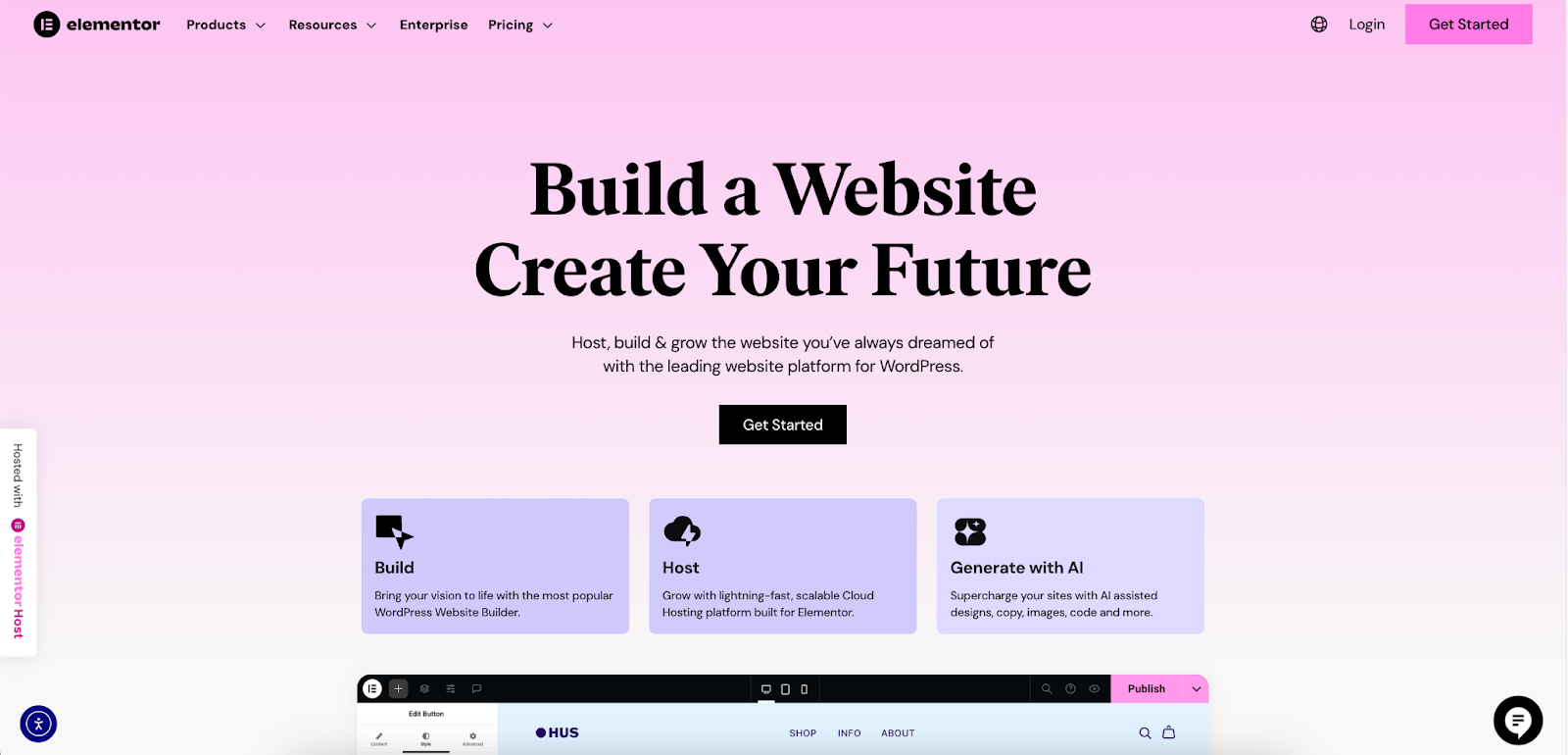
Its intuitive drag-and-drop interface allows you to see your design come to life in real time. For freelancers, this means you can build and manage your own professional online presence quickly and efficiently. Elementor offers a level of design freedom and customization that helps your personal brand stand out.
Key features for freelancers include:
- Portfolio Widgets: Create beautiful, filterable project galleries to showcase your work. You can organize projects by category, allowing potential clients to easily view the work most relevant to them.
- Template Kits: Elementor provides hundreds of professionally designed, full website kits. You can find kits specifically designed for freelance portfolios, digital agencies, and personal brand websites. These kits provide a massive head start, allowing you to import a complete site design and simply customize it with your own text, images, and branding.
- Form Builder: Easily create custom contact forms, detailed project inquiry forms, or client intake questionnaires. This helps you streamline your client onboarding process and gather all the necessary information from the start.
- WooCommerce Integration: For freelancers who want to sell digital products (like e-books or templates) or pre-packaged services directly, Elementor integrates seamlessly with WooCommerce, the leading eCommerce solution for WordPress.
By using a tool like Elementor, you take control of your most important marketing asset. It allows you to create a website that is a true reflection of your brand’s quality and professionalism.
Key Steps to Launching Your Elementor Site
- Get a Domain Name and WordPress Hosting: Choose a domain name that reflects your brand (e.g., yourname.com) and sign up for a reliable WordPress hosting service.
- Install WordPress and the Elementor Plugin: Most hosts offer a one-click WordPress installation. Afterward, you can install the free Elementor plugin directly from your WordPress dashboard.
- Choose a Theme or Kit and Customize Your Design: Start with a lightweight theme like Hello from Elementor or import a full website Kit to get started instantly.
- Build Your Core Pages: Create the essential pages: a homepage that grabs attention, an “About” page to tell your story, a “Services” page detailing your offerings, a “Portfolio” to showcase your work, and a “Contact” page.
- Optimize for SEO: Use SEO plugins and best practices to help your site get found by search engines, turning it into a long-term source of high-quality leads.
Comparing the Top Freelance Websites at a Glance
| Platform | Best For | Fee Structure | Key Feature |
| Upwork | A wide range of freelancers, from beginners to experts. | Sliding scale: 20%, 10%, 5% | All-in-one platform with robust job marketplace. |
| Fiverr | Creatives offering packaged, productized services. | 20% flat commission | “Gig” based model with tiered pricing. |
| Toptal | Elite, senior-level developers, designers, and finance pros. | Pricing is built into the client’s rate. | Rigorous “Top 3%” screening process. |
| Contra | Modern creatives and tech freelancers. | 0% commission | Portfolio-first platform with integrated tools. |
| Your Own Website | All serious freelancers aiming for long-term success. | 0% platform fees (only payment processor fees). | Complete control, brand ownership, and direct client access. |
Export to Sheets
Final Thoughts: Diversify and Conquer
In 2025, the most successful freelancers will be those who think like business owners. This means diversifying your client acquisition channels. Don’t rely solely on a single freelance platform.
A smart approach is to use one or two freelance websites, like Upwork for bidding or Fiverr for packaged services, to generate initial income and leads. Simultaneously, invest time in building your own professional website with a tool like Elementor. This combination allows you to actively find work while passively building a long-term asset that will attract clients, build your authority, and give you true control over your freelance career.
Frequently Asked Questions (FAQ)
What is the best freelance website for beginners?
For beginners, Fiverr can be an excellent starting point because its “gig” model allows you to create a service offering without having to bid on projects. Upwork is also a solid choice due to the sheer volume of jobs available, including many entry-level opportunities.
Are there any freelance websites with no fees?
Yes. Contra is a prominent platform that operates on a 0% commission model, meaning you keep 100% of your earnings from clients. Building your own website also eliminates platform fees entirely, with only standard payment processor fees (like from Stripe or PayPal) applying.
How can I stand out on a crowded freelance platform?
To stand out, you need to specialize. Instead of being a “graphic designer,” be a “logo designer for tech startups.” Additionally, invest in creating a high-quality profile with a professional photo, a compelling bio, and a strong portfolio. Finally, always write personalized, thoughtful proposals or messages to clients that show you’ve read their requirements carefully.
Do I really need my own website if I’m on Upwork or Fiverr?
Yes. While you can find work on those platforms, your profile is subject to their rules, fees, and algorithm changes. Your own website is an asset you control. It acts as a central hub for your brand, allows you to build a direct relationship with clients without a middleman, and establishes you as a serious business owner, not just a gig worker. It’s a critical tool for long-term growth and stability.
Looking for fresh content?
By entering your email, you agree to receive Elementor emails, including marketing emails,
and agree to our Terms & Conditions and Privacy Policy.







